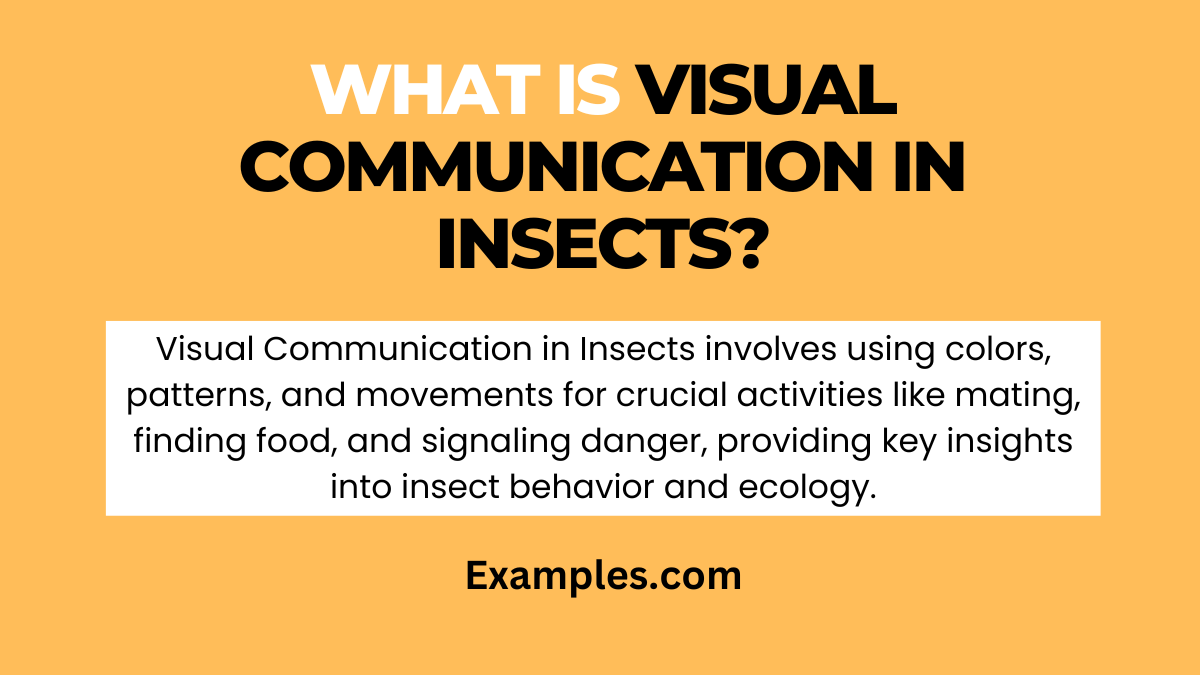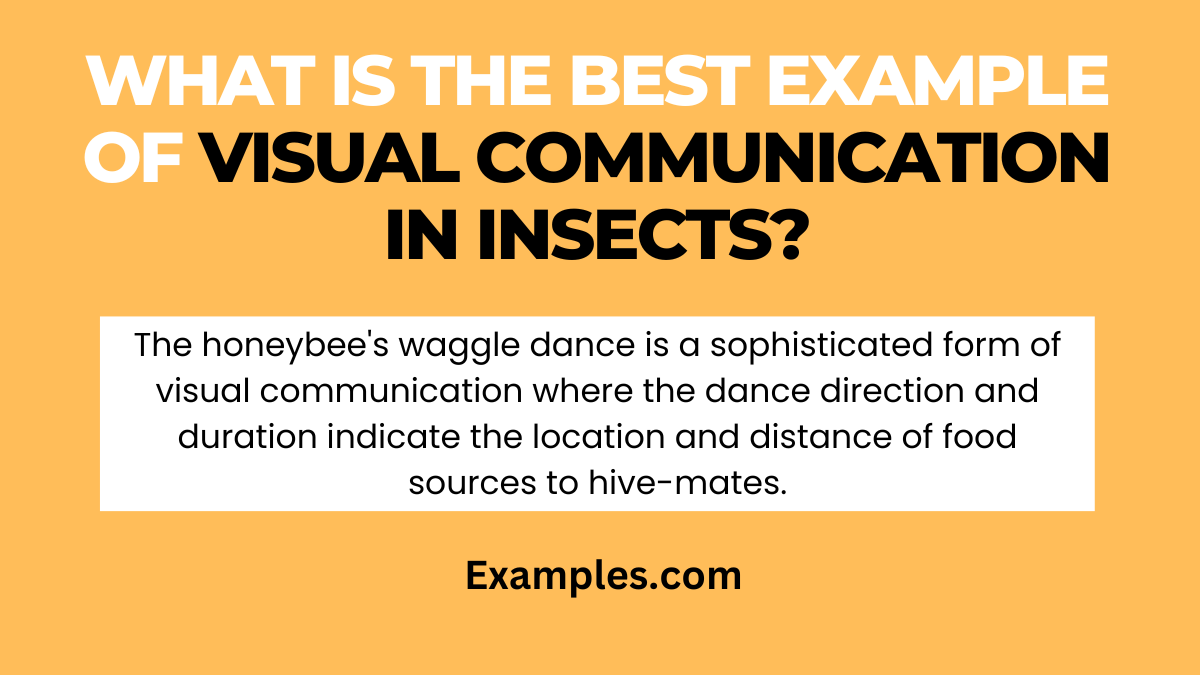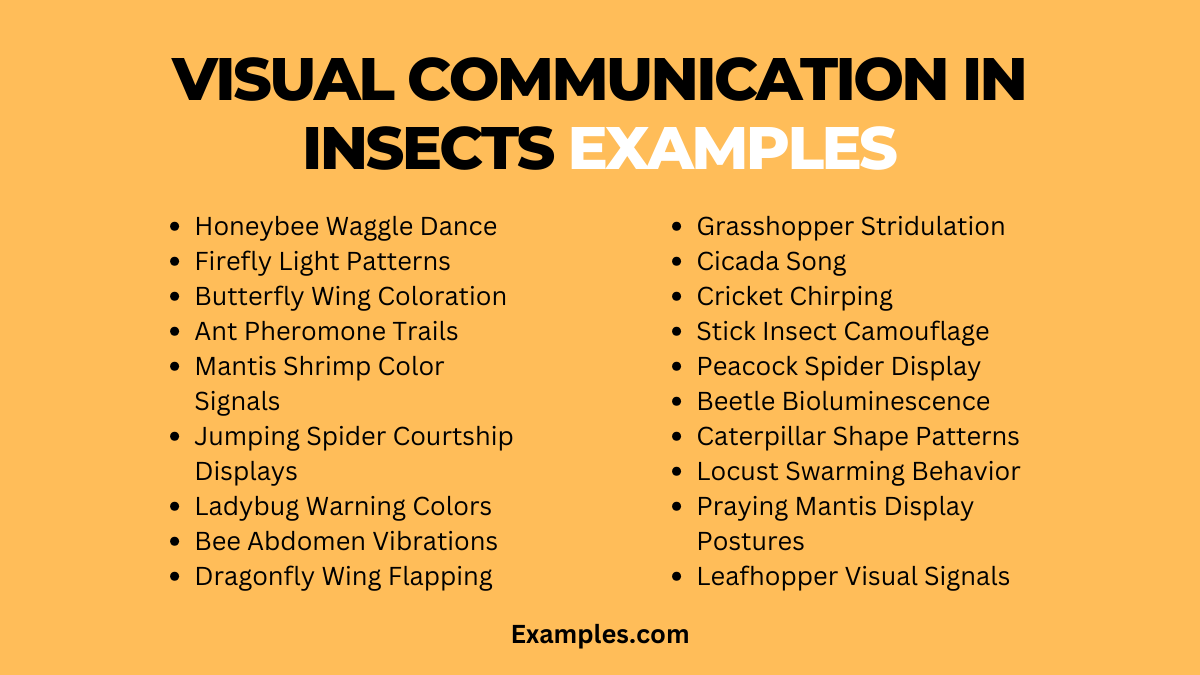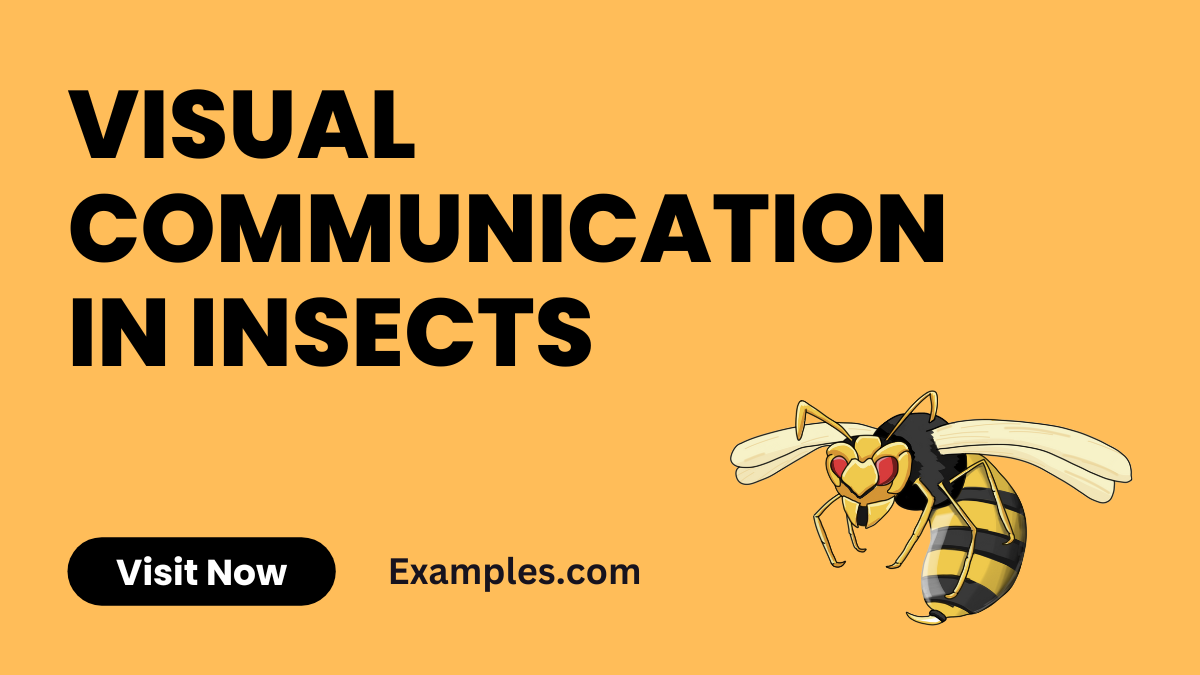19+ Visual Communication in Insects Examples
“Visual Communication in Insects – Complete Guide with Examples” delves into the intricate world of insect interaction, showcasing diverse Communication Examples from the insect kingdom. This guide explores how insects use visual signals, from complex Color Patterns to subtle Body Language Analysis, to interact and survive. It illuminates the fascinating ways insects like bees, butterflies, and ants communicate, offering insights into Insect Signaling Mechanisms and Visual Cues in Insect Behavior, crucial for understanding their unique ecological roles.
Download Importance of Visual Communication in Insects PDF
What is Visual Communication in Insects?

Visual Communication in Insects refers to the way these small creatures use visual elements like color, patterns, and movements to convey information to each other. This type of communication is crucial for various insect activities, including mating, finding food, and warning of danger. For example, the bright colors of a butterfly’s wings can signal its toxicity to predators, and the intricate dances of bees can indicate the location of food. Thus, the study of Visual Communication in Insects offers invaluable insights into how these creatures interact within their ecosystems and with other species.
What is the Best Example of Visual Communication in Insects?

One of the most remarkable examples of Visual Communication in Insects is the honeybee’s waggle dance. This unique form of communication is a sophisticated method used by bees to inform their hive-mates about the location of food sources. When a forager bee discovers a rich source of nectar or pollen, it returns to the hive and performs a dance on the honeycomb. The dance’s direction relative to the sun, conveyed through the angle of the bee’s body in relation to the vertical honeycomb, indicates the direction of the food source. The duration of the waggle phase of the dance communicates the distance to the food source.
20 Visual Communication in Insects Examples

Visual communication in insects is a fascinating and complex field, showcasing a variety of strategies used by these small creatures to convey messages and interact with their environment. This form of communication, rich in Visual Communication Examples and diverse Types of Visual Communication, is critical for insect survival, mating, and social interactions. From the intricate dance of bees to the colorful displays of butterflies, each example underscores the Importance of Visual Communication in the natural world.
- Honeybee Waggle Dance: Indicates direction and distance of food sources.
- Firefly Light Patterns: Used for mating and territorial displays.
- Butterfly Wing Coloration: Signals mate suitability and predator warnings.
- Ant Pheromone Trails: Guides others to food sources.
- Mantis Shrimp Color Signals: Communicate aggression or mating intentions.
- Jumping Spider Courtship Displays: Males perform intricate dances to attract females.
- Ladybug Warning Colors: Indicate toxicity to predators.
- Bee Abdomen Vibrations: Convey different messages within the hive.
- Dragonfly Wing Flapping: Can signal territorial claims.
- Moth Antennae Movements: For sensing pheromones and communication.
- Grasshopper Stridulation: Producing sound by rubbing body parts, used in mating rituals.
- Cicada Song: Used to attract mates.
- Cricket Chirping: Communication for attracting mates and deterring rivals.
- Stick Insect Camouflage: Visual mimicry for hiding from predators.
- Peacock Spider Display: Vibrant abdominal patterns used in mating dances.
- Beetle Bioluminescence: Used for attracting mates or prey.
- Caterpillar Shape Patterns: Can mimic more dangerous organisms.
- Locust Swarming Behavior: Visual cues indicating social and feeding behaviors.
- Praying Mantis Display Postures: Used for defense and intimidation.
- Leafhopper Visual Signals: Body color and movements for mating and defense.
How do insects communicate visually?
Insects use a variety of Visual Communication Examples to interact with each other and their environment, demonstrating diverse Types of Visual Communication. Their Visual Communication Skills are crucial for survival, mating, and territorial defense.
- Coloration and Patterns: Many insects use body coloration and patterns for communication. Bright colors can serve as mating signals or as warning signs to predators, an important aspect of the Importance of Visual Communication.
- Behavioral Displays: Behavioral displays, such as the courtship dances of butterflies or the territorial displays of dragonflies, are common visual communication methods. These displays often involve complex movements and postures.
- Bioluminescence: Insects like fireflies use bioluminescence to attract mates, with each species having a unique light pattern. This phenomenon is a fascinating example of Visual Communication in Insects.
- Mimicry and Camouflage: Mimicry and camouflage are used by insects to deceive predators or prey. This type of visual communication can be so effective that it often features in Visual Communication Journals.
- Pheromone Signaling with Visual Cues: Some insects combine pheromones with visual cues to communicate. For example, bees use pheromones along with their waggle dance to enhance the message about food location.
- Wing Flapping and Vibrations: Certain insects communicate through wing flapping and vibrations, which can be visually perceptible to other insects, an aspect studied in How Visual Communication Works.
- Structural Communication: Some insects use parts of their structure, like the antennae or mandibles, to communicate visually, often accentuated with movement.
What are the Importance of Visual Communication in Insects?
The Importance of Visual Communication in Insects cannot be overstated, as it plays a critical role in their survival, reproduction, and social structures. Visual signals are a primary mode of communication in the insect world, given their often limited auditory and verbal capabilities. These Visual Communication Examples highlight the adaptability and complexity of insect behavior.
- Survival: Many insects use visual signals like coloration and mimicry for survival. For instance, the bright colors in some species can warn predators of toxicity, a concept explored in Visual Communication Journals.
- Reproduction: Insects like butterflies and fireflies use visual cues, such as color patterns and light signals, for mate attraction, an essential aspect of their reproductive cycle.
- Social Interaction: Social insects like bees and ants demonstrate complex Types of Visual Communication. The honeybee’s waggle dance is a perfect example, guiding hive mates to food sources.
- Territorial and Defense Mechanisms: Visual signals are also used for territorial defense. Certain insect species display specific colors or patterns to deter invaders or predators, a key Characteristic of Visual Communication.
- Navigating and Foraging: Insects rely on visual cues for navigation and locating food. The ability to interpret and respond to these cues is a critical Visual Communication Skill.
- Evolutionary Advantage: The development of visual communication aids in the evolutionary success of insects, allowing them to adapt to diverse environments.
- Study and Research Opportunities: Understanding How Visual Communication Works in insects offers valuable insights for researchers, contributing to fields like ecology, biology, and even robotics. It also opens avenues for Visual Communication Jobs, Careers, Salaries.
- Educational and Media Representation: Depicting these communication methods in educational materials and Visual Communication in the Media enhances public understanding of insect life and biodiversity.
In essence, visual communication is integral to the life and success of insects. It influences their interactions, survival strategies, and evolutionary paths, underscoring the Importance of Visual Communication in the natural world. Understanding these mechanisms not only enriches our knowledge of entomology but also offers broader ecological insights.
What are the Types of Visual Communication in Insects?
Insects use a variety of Types of Visual Communication, each fascinating and unique, playing a crucial role in their survival and interaction. Understanding these types is essential in the field of entomology and offers valuable insights for anyone interested in Visual Communication Examples and the Characteristics of Visual Communication.
- Coloration and Patterns: Many insects use bright colors or specific patterns on their bodies to communicate. For instance, bright colors can be a warning signal to predators about the insect’s toxicity, a phenomenon studied in various Visual Communication Journals.
- Body Movements: Insects often communicate through specific body movements. A well-known example is the waggle dance of bees, which indicates the direction and distance of food sources. This showcases their unique Visual Communication Skills.
- Wing Signals: Wing patterns and movements can be a form of communication, particularly in butterflies and moths. These visual signals can convey messages about mating availability or territorial claims.
- Light Emission: Some insects, like fireflies, communicate through bioluminescence. The light patterns emitted serve as mating calls or territorial signals, highlighting the Importance of Visual Communication in these species.
- Mimicry and Camouflage: Mimicry is a visual communication strategy where an insect mimics another organism’s appearance to avoid predation, a subject often explored in Visual Communication in the Media.
- Structural Displays: Certain insects, like peacock spiders, use structural features like colorful abdomens for communication during mating rituals. This form of visual display is key in understanding How Visual Communication Works in nature.
- Pheromone Trails: While primarily chemical, pheromone trails can have a visual component, as seen in ants. The trail, although invisible to the human eye, is a vital visual cue for other ants.
- Courtship Displays: Many insects engage in visual courtship displays, which can include specific dances, postures, or physical changes. These rituals are critical for mating and species propagation.
- Territorial Displays: Territorial insects often use visual signals to claim and defend their territory from rivals.
- Warning and Alarm Signals: Visual warnings, such as the sudden display of bright colors or patterns, serve to alert other insects of danger or to ward off predators.
What Do Insects Use for Communication?
Insects use a combination of visual signals, chemical cues (pheromones), body movements, and sounds to communicate with each other, each method serving different purposes.
Do All Insects Communicate with Each Other?
Yes, all insects communicate, but the methods vary greatly among species. They use visual cues, pheromones, sounds, and tactile signals to interact within their environments.
How Do Insects Visually Communicate with Sound?
Insects visually communicate with sound by using visual cues alongside auditory signals, like a cricket’s chirp accompanied by specific movements, to enhance the communication effectiveness.
In conclusion, the study of Visual Communication in Insects unveils a fascinating aspect of the natural world, where even the smallest creatures exhibit complex and sophisticated ways of interacting. From the intricate dances of bees to the luminous displays of fireflies, each form of communication not only plays a pivotal role in the survival of these species but also offers invaluable insights into the rich tapestry of life on Earth. For those keen on delving deeper into the nuances of insect communication, the American Chemical Society provides an in-depth look into how insects use both visual and chemical signals (Decoding how insects use visual and chemical communication). Additionally, North Carolina State University’s Department of Entomology offers a comprehensive guide on various aspects of insect communication, including visual signals (NCSU Entomology: Visual Communication in Insects).



